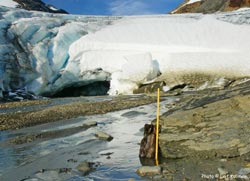Melting glaciers reveal future alpine world

Caption: Subfossil of birch, 9,060 years old, shows how high the treeline has been in the Swedish mountains. Photo: Leif Kullman<br>
Remains of trees that have been hidden for thousands of years have been uncovered. They indicate that 13,000 years ago there were trees where there are now glaciers. The climate may have been as much as 3.5 degrees warmer than now. In other words, this can happen again, according to Lisa Öberg, a doctoral candidate at Mid Sweden University in a new study.
In her study Lisa Öberg shows that soon after the inland ice receded, about 13,100 years ago, pines colonized high altitudes in the mountains. A few thousand years later there was a massive invasion of both pines and birches at levels up to 600 m higher than today’s treeline. Subsequently the treeline for both pine and birch was gradually lowered as a result of ever-lower temperatures, until the climate made it impossible for trees to grow and glaciers began to form, about 4,400 years ago.
“We used to think that the glaciers were remnants of the latest ice age. The fact that trees grew there so recently shows that the glaciers are no older than 4,400 years,” says Lisa Öberg.
Lisa Öberg’s study is based on finds of tree remains from Helags-Sylarna, Tärna, and Abisko. The age of the tree remains shows that the climate warming of the last century is unique in a perspective of several thousands of years. If any melting corresponding to what is happening today had taken place previously, the wood would probably have been degraded.
“The knowledge we gain by exploiting this unique opportunity is important for our understanding of how alpine plant growth may be impacted by the future climate,” says Lisa Öberg.
The fact that nearly 10,000 years ago birches grew 600 m above today’s treeline in a climate that was some 3.5 degrees warmer than today shows that trees ought to be able to grow at the same level again, if the temperature rises a few more degrees.
“By studying where the treeline ran in the past, we can see what it can be like in the future if it continues to get warmer,” says Lisa Öberg.
Article “Recent Glacier Recession – a New Source of Postglacial Treeline and Climate History in the Swedish Scandes” by Lisa Öberg & Leif Kullman
Questions can be posed to:
Lisa Öberg, fil.lic./doctoral candidate, mobile: +46 (0)76-8230068
Media Contact
More Information:
http://www.landscapeonline.de/All latest news from the category: Earth Sciences
Earth Sciences (also referred to as Geosciences), which deals with basic issues surrounding our planet, plays a vital role in the area of energy and raw materials supply.
Earth Sciences comprises subjects such as geology, geography, geological informatics, paleontology, mineralogy, petrography, crystallography, geophysics, geodesy, glaciology, cartography, photogrammetry, meteorology and seismology, early-warning systems, earthquake research and polar research.
Newest articles

A flexible and efficient DC power converter for sustainable-energy microgrids
A new DC-DC power converter is superior to previous designs and paves the way for more efficient, reliable and sustainable energy storage and conversion solutions. The Kobe University development can…

Technical Trials for Easing the (Cosmological) Tension
A new study sorts through models attempting to solve one of the major challenges of contemporary cosmic science, the measurement of its expansion. Thanks to the dizzying growth of cosmic…

Peptides on Interstellar Ice
A research team led by Dr Serge Krasnokutski from the Astrophysics Laboratory at the Max Planck Institute for Astronomy at the University of Jena had already demonstrated that simple peptides…




















